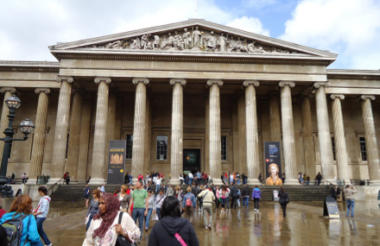The British Museum has seen its costs rise by £23.6m amid inflationary pressures and supply chain constraints.
Accounts for the year to March 2023 show that the charity’s total expenditure was £103.4m, compared with £79.8m the previous year.
Most of the charity’s sources of expenditure increased in 2022-23, as it “has unavoidably high fixed costs due to its obligation to care for and secure the collection”, the accounts say.
Meanwhile, the charity’s total income and endowments increased by 24% to £134.8m, boosted by “one large individual gift”, while it continued to face volunteer recruitment challenges.
‘Steep increases in costs’
The accounts say that “the museum has seen steep increases in costs in the year as a result of inflationary pressures and supply chain constraints”.
It spent £51.4m on care, research and conservation, compared with £43.2m in 2021-22.
Expenditure on charitable activity increased by £20.2m to £91.7m while expenditure on other trading activities rose from £5.9m to £8.7m.
The accounts read: “Recovering from the impact of the Covid-19 pandemic has remained a challenge. Visitor numbers have continued to grow following the end of pandemic-related restrictions in the UK, reaching 4.5 million for the financial year as whole.
“This represents around three-quarters of our pre-pandemic visit numbers, with slow recovery of international tourism accounting for a significant part of the shortfall.”
Recovery in income
Despite the challenges, income increased by £25.8m to £134.8m in 2022-23 after a previous fall of 12% year-on-year.
Admissions income was slightly higher, rising from £2.8m to £3.1m, while fundraising income (excluding donations in kind) went from £17.2m to £31.3m.
Trading income, which includes international touring exhibitions among other things, increased by £5m to £11.2m.
The charity received donations and legacies worth £27.6m (£13.5m in 2021-22), with “one large individual gift” accounting for the majority of the increase in the year.
“During the Covid-19 pandemic the BM Group saw its income fall substantially, with activity in the trading subsidiaries particularly badly affected,” the accounts read.
“Further additional funding was received from DCMS within the year, and the trustees are very grateful for the ongoing support which has helped recovery. Since 2021-22 visitor numbers have recovered gradually, with increased admissions and trading income for the year.”
‘Significant gaps in volunteer rota’
The charity had “just over 440” volunteers at March 2023, a drop on the over 500 it had pre-pandemic.
“Although all volunteer programmes had resumed by the end of 2022 following the lifting of restrictions, there have been significant gaps in volunteer rotas throughout 2022-23,” it wrote in the accounts.
“Recruitment has been a major priority for 2022-23 and will continue to be so during 2023-24. A priority for the volunteer office is recruiting new volunteers from less traditional and more diverse backgrounds, helping to diversify the team as a whole.”
To address this, the charity appointed a three-year volunteer manager focusing on access and equality in October 2022.
“This post is helping to continue to adapt our recruitment processes to increase accessibility and to encourage applications from a wider range of people. We now run online webinars to answer questions to help people feel more informed about what is involved and hopefully more likely to apply,” its accounts read.
“We also offer more support with writing applications and we are working to develop and offering a variety of flexible roles, including pop-up tours. Adverts for new volunteer roles have been shared with community partners as part of a concerted effort to reach new audiences.”
Related articles











